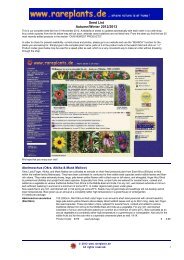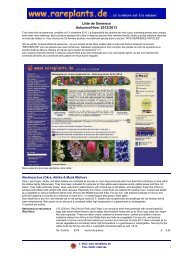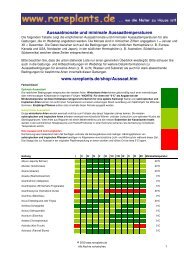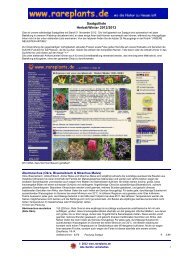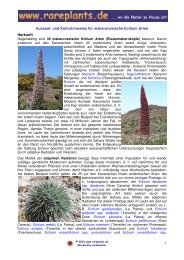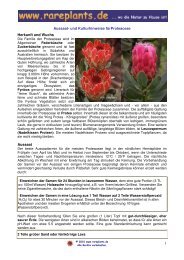Lista de Semillas Otoño/Invierno 2012/2013 - Bjorn Malkmus Rare ...
Lista de Semillas Otoño/Invierno 2012/2013 - Bjorn Malkmus Rare ...
Lista de Semillas Otoño/Invierno 2012/2013 - Bjorn Malkmus Rare ...
You also want an ePaper? Increase the reach of your titles
YUMPU automatically turns print PDFs into web optimized ePapers that Google loves.
Abelmoschus manihot<br />
(Aibika)<br />
Abelmoschus moschatus<br />
(Musk Mallow)<br />
Abrus (Jequirity Beans)<br />
150 (200)cm, Aibika, Sunset Muskmallow, Sunset Hibiscus, or Hibiscus Manihot is an annual to shortlived<br />
perennial with extremely showy and beautiful, large pale lemon-yellow flowers with a small dark<br />
center and pointed-oval, <strong>de</strong>nsely pubescent seed capsules above broadly lobed leaves. In Asia and<br />
Australia very young leaves and still smoothly pubescent seed capsules are used as vegetables, the semiwoody<br />
stem is used for being rich in fiber. For any rich, well drained substrate in full sun and sufficient<br />
watering in summer at a minimum of some 20°C. Best cultivated as an annual at a constantly rather high<br />
temperature in a greenhouse or wintergar<strong>de</strong>n. VII-IX.<br />
No. <strong>de</strong> artículo: 8379 sobre <strong>de</strong> semillas<br />
€ 2,99<br />
150 (200)cm, Musk Mallow o<strong>de</strong>r Ambrette Seeds is an annual to short-lived perennial native of India with<br />
very showy and large, pale lemon-yellow flowers with a small dark center and flattened oval, <strong>de</strong>nsely<br />
pubescent seed capsules above broadly lobed leaves and musk fragrant seeds. In India and Asia very<br />
young leaves, still smoothly pubescent seed capsules and young flower buds are cooked as vegetables.<br />
Several plant parts are used in traditional medicine. The seed oil was used as a plant substitute for animal<br />
musk. For any rich, well drained substrate in full sun and sufficient watering in summer at a minimum of<br />
some 20°C. Best cultivated as an annual at a constantly rather high temperature in a greenhouse or<br />
wintergar<strong>de</strong>n. VII-IX.<br />
No. <strong>de</strong> artículo: 8380 sobre <strong>de</strong> semillas<br />
€ 2,99<br />
Jequirity Beans is a monotypic genus with only one species It grows as a twining, perennial woody vine with large toothed feathered leaves<br />
and white, pale rose or pale bluish-rose pea like flowers followed by brown seedpods containing showy scarlet red seeds with a black<br />
base. Easily grown as pot plants in any rich, well drained soil in a sunny spot throughout the year. Keep plants drier in winter at a minimum<br />
of some 10°C. Plants require a climbing aid.<br />
Prior to sowing scarify seed (e.g. carefully scratch the seed coat with fine sandpaper) and soak them in luke warm water for some 48h.<br />
Sow flat in any rich, well drained soil at some 20°C.<br />
7 semillas por sobre.<br />
Abrus precatorius<br />
(Coral Jequirity Bean)<br />
Abutilon (Flowering Maple)<br />
300 (700)cm, Coral Jequirity Bean is a climbing, woody perennial with feathered leaves, white to pale<br />
bluish-pink flowers followed by brownish seedpods with most ornamental brilliant scarlet seeds with a<br />
black spot. VII-VIII.<br />
No. <strong>de</strong> artículo: 0108 sobre <strong>de</strong> semillas<br />
€ 4,99<br />
The genus of Flowering Maple covers some 100 herbaceous species from the Mallow family (Malvaceae) and is found in tropical to<br />
subtropical areas throughout the world. Several species have beautiful, five-petaled, and usually nodding flowers, and are easily cultivated<br />
in any rich, well drained soil in a sunny spot throughout the year. In winter keep plants slightly drier at a minimum of some 10°C. If plants<br />
become to large, they may be cut back in spring.<br />
Sow at some 20°C throughout the year in any rich, very well drained soil. Keep seedlings in full sun, especially if they are sowed in winter<br />
months.<br />
20 semillas por sobre.<br />
Abutilon grandifolium<br />
(Large-leafed Indian Mallow)<br />
50 (120)cm, Large-leafed Indian Mallow is a biannual to perennial species with large, <strong>de</strong>nsely pubescent,<br />
heart shaped leaves and numerous slightly nodding, orange flower cups over a very long period. After<br />
flowering it makes some typical, upright hold seed pods. For any rich, well drained soil in a sunny spot<br />
throughout the year, reduce watering in winter and keep plants at a minimum of some 15°C. VI-XI.<br />
No. <strong>de</strong> artículo: 3441 sobre <strong>de</strong> semillas<br />
€ 0,99<br />
Abutilon pycnocodon 80 (180)cm, makes a woody perennial shrub with showy pale pink flowers with a dark pink throat. For any<br />
rich, well drained substrate in a sunny spot throughout the year. In winter keep drier at a minimum of<br />
some 10°C. VII-IX.<br />
No. <strong>de</strong> artículo: 6017 sobre <strong>de</strong> semillas<br />
€ 4,99<br />
Abutilon sonneratianum 40 (70)cm, makes a semi-woody perennial, low subshrub with nice orange-yellow flowers. For any rich,<br />
well drained substrate in a sunny spot throughout the year. In winter keep drier at a minimum of some<br />
10°C. VII-IX.<br />
Abutilon theophrasti<br />
(Indian Velvet-leaf Mallow)<br />
Acacia (Wattle Shrubs)<br />
No. <strong>de</strong> artículo: 6016 sobre <strong>de</strong> semillas<br />
€ 0,99<br />
120 (180)cm, Indian Velvet-leaf Mallow is a fast growing annual from South Asia with branching stems<br />
and showy yellowish- orange flowers above serrated, heart-shaped, pubescent leaves. Easily cultivated in<br />
any rich, well drained, rather rocky soil in full sun. Sow directly to the ground after the last freezing nights<br />
in late spring to early summer. VII-IX.<br />
No. <strong>de</strong> artículo: 4773 sobre <strong>de</strong> semillas<br />
€ 2,99<br />
Acacia or Wattle Shrubs are in general subtropical to tropical woody shrubs to trees from a broad genus with numerous species. They<br />
have usually elegant feathered or crescent-shaped leaves and ornamental, <strong>de</strong>nse clusters of pure white to bright yellow flower balls. Cut<br />
branches of many species are wi<strong>de</strong>ly used in the floristry. In general wattles are easily cultivated as container plants in any rich, well<br />
drained soil in a sunny and frostfree spot throughout the year. In winter keep plants cooler at a minimum of some 10°C with reduced<br />
watering. Some species may lose several leaflets in winter, especially if they are kept rather cold, however they will resprout vigorously in<br />
spring. Plants which have become to large may be cut back in spring before the new growth.<br />
Prior to sowing scarify seed (e.g. carefully scratch the seed coat with fine sandpaper) and soak them in luke warm water for some 48h.<br />
Sow flat at a minimum of some 20°C throughout the year in any leafy-sandy, well drained soil in a sunny spot. Keep seedlings in full sun.<br />
20 semillas por sobre unless noted differently.<br />
Acacia acinacea 2.50 m, Gold-dust Wattle or Round-leaved Wattle has ornamental bluish green, oblong-elliptic to broadovate<br />
pseudo-leaves and lose gol<strong>de</strong>n ball-like flowers on long pedicles. Native of south-eastern Australia<br />
growing in sandy soils in open woodlands. VII-IX.<br />
© <strong>2012</strong> www.rareplants.<strong>de</strong><br />
Todos los <strong>de</strong>rechos reservados.<br />
2




